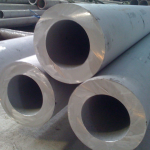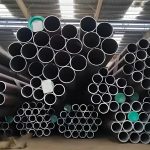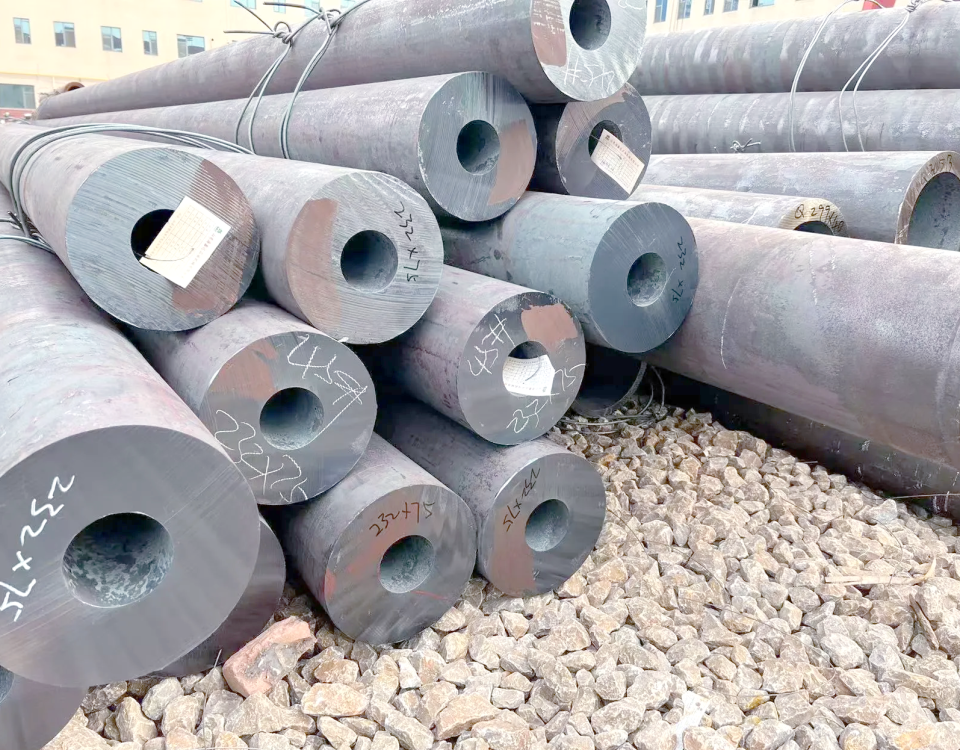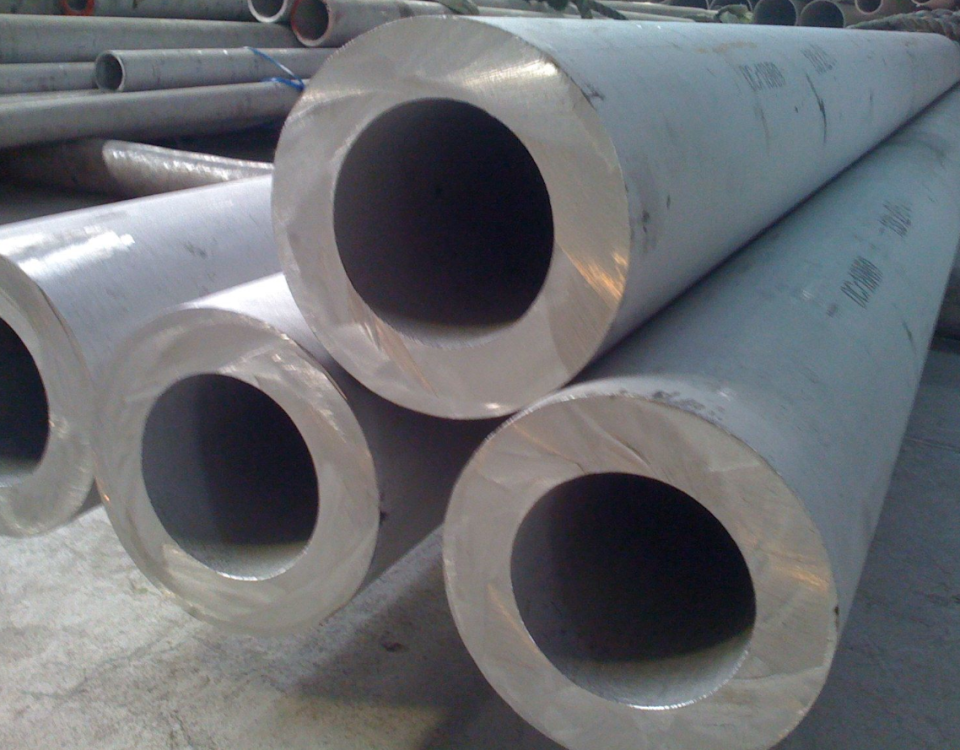
Heavy Wall Stainless Steel Pipe Scientific Analysis
June 4, 2025
Petroleum Cracking Seamless Steel Pipe
June 7, 2025Comprehensive Scientific Analysis of Thick Wall Seamless Steel Pipe
Manufacturing and Microstructural Characteristics
Thick wall seamless steel pipes are manufactured by perforating solid steel billets, typically through hot-rolling or cold-drawing, to create a seamless tubular structure without welds. This process ensures a uniform microstructure, free from seam-related imperfections, making them ideal for high-pressure and high-stress applications. The wall thickness (WT) ranges from SCH XS to SCH XXS (6-60 mm), with outer diameters (OD) from 1/8” to 24” and lengths up to 12 m, per standards like ASTM A106, A333, DIN 1629, and EN 10216. Steel grades, such as ASTM A106 Gr. B (C ≤0.30%, Mn 0.29-1.06%) and EN S355J2H (C ≤0.20%, Mn ≤1.60%), are tailored for strength and toughness. Hot-rolling at temperatures above 900°C refines grain structure, achieving yield strengths of 240-355 MPa, while cold-drawing enhances surface finish and dimensional precision (±0.20 mm for small ODs). The absence of welds eliminates weak points, enabling these pipes to withstand pressures 20% higher than welded equivalents. Alloying elements like chromium and molybdenum in grades like A333 Gr. 6 enhance low-temperature toughness, critical for applications in oil, gas, and chemical transport.
Mechanical Properties and Load-Bearing Capacity
Thick wall seamless steel pipes are designed for demanding mechanical environments, offering superior strength and durability. Grades like ASTM A106 Gr. B and EN S355J2H provide tensile strengths of 415-520 MPa and yield strengths of 240-355 MPa, with elongation ≥30%, ensuring ductility under high pressure. The thick walls (SCH 80 to XXS) increase the section modulus, enhancing resistance to bending and torsional stresses compared to thinner pipes. For example, a 6” OD pipe with SCH 160 (WT ~21 mm) can handle internal pressures exceeding 50 MPa, per ASME B31.3 calculations. Low-temperature grades like ASTM A333 Gr. 6 maintain toughness at -45°C, with Charpy impact values ≥27 J, suitable for cryogenic systems. The seamless structure minimizes stress concentrations, unlike welded pipes, reducing risks of fatigue failure under cyclic loading. Standards like JIS G3454 (STPG410) and DIN 1629 (ST52) ensure tight control of sulfur (≤0.025%) and phosphorus (≤0.025%), preventing brittleness. These properties make thick wall seamless pipes ideal for high-pressure fluid delivery and structural supports in harsh conditions.
Corrosion Resistance and Environmental Performance
While carbon steel grades like ASTM A53 and A106 lack inherent corrosion resistance, thick wall seamless pipes mitigate this through design and coatings. The increased wall thickness (SCH 100-XXS) extends service life by allowing greater material loss before failure, critical in corrosive water, oil, or gas environments. For instance, unlined A106 Gr. B pipes in chloride-rich water (500 ppm) corrode at 0.5-1 mm/year, but epoxy or polyethylene coatings reduce this to <0.1 mm/year. Grades like ASTM A333 Gr. 6, with low carbon (≤0.30%) and manganese (0.29-1.06%), resist stress corrosion cracking (SCC) better than welded pipes due to uniform microstructure. Standards like EN 10216 and JIS G3456 specify compositions to minimize inclusions, enhancing durability. In aggressive environments, external coatings (e.g., 3PE) and cathodic protection (-850 mV vs. Cu/CuSO₄) are applied. However, internal corrosion remains a challenge, requiring inhibitors or linings. These pipes are vital for chemical processing, power plants, and pipelines, where reliability under corrosive stress is paramount.
Comparative Analysis and Application Optimization
Thick wall seamless steel pipes outperform welded pipes in pressure capacity and fatigue resistance, due to their seamless structure, but are costlier (15-25% higher). Compared to thin-walled pipes, they offer greater durability in high-pressure systems, with SCH 160 pipes supporting up to 70 MPa versus 30 MPa for SCH 40. Grades like ASTM A106 Gr. C (485 MPa tensile) and EN S355J2H (470 MPa) suit heavy-duty applications, while A333 Gr. 6 excels in low temperatures. Seamless pipes are preferred for critical systems like oil and gas pipelines, per API 5L, and boiler tubes, per ASTM A192, over welded alternatives due to uniform strength. End finishes (plain, beveled, threaded) and packing (bundled or bulk) ensure versatility, with delivery within 30 days. Selection depends on pressure, temperature, and environment: A106 for high-temperature fluid delivery, A333 for cryogenic, and S355J2H for structural use. Future advancements include corrosion-resistant coatings and smart monitoring for extended life. Tables below compare dimensions and properties for optimal selection.
Dimension Range by Application
| Application | OD Range | WT Range | Length Range | Standards |
|---|---|---|---|---|
| High-Pressure Fluid | 1/8” – 24” | SCH 80, 120, 160, XXS | Up to 12 m | ASTM A106, A53, JIS G3454, EN 10216 |
| Low-Temperature Service | 1/2” – 20” | SCH 80, 100, 160 | Up to 12 m | ASTM A333, EN 10216 |
| Boiler Tubes | 1/2” – 12” | SCH 80, 120, XXS | Up to 12 m | ASTM A192, A210, JIS G3456 |
| Structural Supports | 1/8” – 24” | SCH XS, 80, STD | Up to 12 m | ASTM A500, EN 10210, JIS G3445 |
Chemical Composition and Mechanical Properties
| Standard | Grade | C (%) | Si (%) | Mn (%) | P (%) | S (%) | Tensile Strength (min MPa) | Yield Strength (min MPa) | Elongation (%) |
|---|---|---|---|---|---|---|---|---|---|
| ASTM A106 | B | ≤0.30 | ≥0.10 | 0.29-1.06 | ≤0.035 | ≤0.035 | 415 | 240 | ≥30 |
| ASTM A106 | C | ≤0.35 | ≥0.10 | 0.29-1.06 | ≤0.035 | ≤0.035 | 485 | 275 | ≥30 |
| ASTM A333 | Gr. 6 | ≤0.30 | ≥0.10 | 0.29-1.06 | ≤0.025 | ≤0.025 | 415 | 240 | ≥30 |
| EN 10216 | P265TR1 | ≤0.20 | ≤0.40 | ≤1.40 | ≤0.025 | ≤0.020 | 410 | 265 | ≥27 |
| EN 10210 | S355J2H | ≤0.20 | ≤0.55 | ≤1.60 | ≤0.035 | ≤0.035 | 470 | 355 | ≥22 |
| JIS G3454 | STPG410 | ≤0.30 | ≤0.35 | 0.30-1.00 | ≤0.040 | ≤0.040 | 410 | 245 | ≥25 |
Extended Scientific Analysis of Thick Wall Seamless Steel Pipe
Microstructural Optimization and Processing Effects
Thick wall seamless steel pipes owe their robust performance to advanced manufacturing techniques and precise microstructural control. Hot-rolling at temperatures above 900°C aligns the grain structure, producing a uniform ferrite-pearlite or bainitic matrix, which enhances yield strengths (240-355 MPa) in grades like ASTM A106 Gr. B and EN S355J2H. Cold-drawing further refines grain size, increasing strength and surface quality, with dimensional tolerances as tight as ±0.20 mm for ODs <10 mm, per ASTM A519. Alloying elements—carbon (≤0.35%), manganese (0.29-1.60%), and low sulfur/phosphorus (≤0.035%)—are optimized to minimize inclusions and brittleness, per standards like JIS G3454 and DIN 1629. For low-temperature grades like ASTM A333 Gr. 6, niobium or vanadium additions promote fine-grained structures, boosting toughness (Charpy impact ≥27 J at -45°C). The seamless process eliminates weld imperfections, ensuring uniform stress distribution under high pressures (up to 70 MPa for SCH 160). Heat treatments, such as normalizing or quenching, further enhance mechanical properties, making these pipes critical for high-pressure fluid delivery, cryogenic systems, and structural applications in oil, gas, and power industries.
High-Pressure Performance and Design Considerations
Thick wall seamless steel pipes excel in high-pressure environments due to their enhanced wall thickness (SCH 80-XXS, 6-60 mm) and seamless construction. The increased wall thickness raises the hoop stress capacity, allowing pipes like ASTM A106 Gr. C (485 MPa tensile) to withstand internal pressures exceeding 50 MPa, per ASME B31.3. The absence of welds eliminates stress concentration points, reducing risks of fatigue failure under cyclic loading, unlike welded pipes, which may fail at seams. Grades like EN P265TR1 and JIS STPG410 offer balanced strength and ductility (elongation ≥25-30%), supporting applications in boiler systems, chemical processing, and oil pipelines. Design considerations include precise end finishes—plain, beveled, or threaded—for secure connections and seaworthy packing (bundled or bulk) for delivery within 30 days. However, thick walls increase weight, impacting installation costs. Future designs aim to optimize wall thickness via finite element analysis (FEA), balancing strength and material efficiency, while smart sensors monitor pressure and corrosion in real-time for enhanced reliability.
Comparative Performance and Application Optimization
Thick wall seamless steel pipes outperform welded pipes in high-pressure and high-stress scenarios due to their uniform structure and superior fatigue resistance. Compared to thin-walled pipes (SCH 10-40), thick wall pipes (SCH 80-XXS) offer 2-3 times higher pressure capacity, critical for oil and gas pipelines (API 5L) and boiler tubes (ASTM A192). For instance, ASTM A333 Gr. 6 supports cryogenic conditions (-45°C), while EN S355J2H excels in structural applications with 355 MPa yield strength. Stainless steel pipes provide better corrosion resistance but cost 20-30% more, making thick wall seamless carbon steel a cost-effective choice for moderate corrosion environments with coatings. Selection hinges on pressure, temperature, and cost: A106 Gr. B for high-temperature fluids, A333 Gr. 6 for low temperatures, and S355J2H for structural frameworks. Advances in corrosion-resistant coatings (e.g., graphene-based) and AI-driven monitoring promise extended service life. Tables below compare dimensions and properties for optimal application.
Dimension Range by Application
| Application | OD Range | WT Range | Length Range | Standards |
|---|---|---|---|---|
| High-Pressure Fluid | 1/8” – 24” | SCH 80, 120, 160, XXS | Up to 12 m | ASTM A106, A53, JIS G3454, EN 10216 |
| Low-Temperature Service | 1/2” – 20” | SCH 80, 100, 160 | Up to 12 m | ASTM A333, EN 10216 |
| Boiler Tubes | 1/2” – 12” | SCH 80, 120, XXS | Up to 12 m | ASTM A192, A210, JIS G3456 |
| Structural Supports | 1/8” – 24” | SCH XS, 80, STD | Up to 12 m | ASTM A500, EN 10210, JIS G3445 |
Chemical Composition and Mechanical Properties
| Standard | Grade | C (%) | Si (%) | Mn (%) | P (%) | S (%) | Tensile Strength (min MPa) | Yield Strength (min MPa) | Elongation (%) |
|---|---|---|---|---|---|---|---|---|---|
| ASTM A106 | B | ≤0.30 | ≥0.10 | 0.29-1.06 | ≤0.035 | ≤0.035 | 415 | 240 | ≥30 |
| ASTM A106 | C | ≤0.35 | ≥0.10 | 0.29-1.06 | ≤0.035 | ≤0.035 | 485 | 275 | ≥30 |
| ASTM A333 | Gr. 6 | ≤0.30 | ≥0.10 | 0.29-1.06 | ≤0.025 | ≤0.025 | 415 | 240 | ≥30 |
| EN 10216 | P235TR1 | ≤0.16 | ≤0.35 | ≤1.20 | ≤0.025 | ≤0.020 | 360 | 235 | ≥25 |
| EN 10210 | S355J2H | ≤0.20 | ≤0.55 | ≤1.60 | ≤0.035 | ≤0.035 | 470 | 355 | ≥22 |
| JIS G3454 | STPG370 | ≤0.25 | ≤0.35 | 0.30-0.90 | ≤0.040 | ≤0.040 | 370 | 215 | ≥30 |



